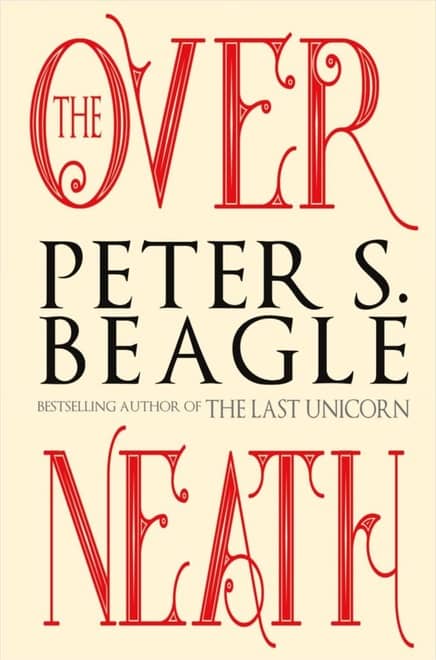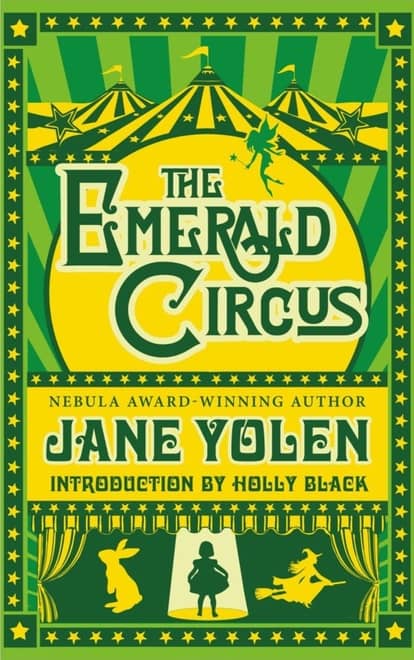Fantasy as Something Brighter: Peter S. Beagle’s The Overneath and Jane Yolen’s The Emerald Circus
 |
 |
The Overneath by Peter S. Beagle (Tachyon Publications, 336 pages, $15.95 in trade paperback, November 14, 2017)
The Emerald Circus by Jane Yolen (Tachyon Publications, 288 pages, $15.95 in trade paperback, $9.99 digital, November 14, 2017)
In 1900 Frank L. Baum published The Wonderful Wizard of Oz, arguably the first truly American fairy tale. Now, a century and counting along the Yellow Brick Road, what can be said about the current state of the fairy tale in America? We seem deep in the wilds of dystopias like Hunger Games and its darker cousin, The Walking Dead, captivated by the grim fantasies of American Gods and Game of Thrones. Is this the new reality for the American fable, for literary fantasy that aspires to be anything more than a Disney retelling?
Against this darker background, a pair of recent collections from San Francisco’s Tachyon Publications attempts to reestablish or at least reconfirm fantasy as something brighter, if no less compelling. The Overneath by Peter S. Beagle and The Emerald Circus by Jane Yolen (both published November 2017) together provide a sample of American fantasy by two of its most enduring and cherished voices. Beagle and Yolen are both giants, with hundreds of publications and dozens of awards between them. They have won the highest accolades in the fields, and both now write from positions of something like legend. But do the unicorns of Beagle or the Arthurian retellings of Yolen have anything to give readers who have come to expect a heavy dose of grim realism or even grimmer apocalypse in their high fantasy?
Beagle has had a run of publications lately from Tachyon, starting with his novel Summerlong, followed by In Calabria, and now this collection of short stories. I’ve argued in previous reviews that both Summerlong and In Calabria draw on wells Beagle sunk decades ago, particularly his firm footing in urban fantasy and his unicorn legacy. In this collection, Beagle continues to draw from those sources, with ongoing success. For The Overneath, he plumbs the corpus of unicorn legends, attempting here a series of stories treating the creatures in their various classical guises. He has one about the sublime, otherworldly Chinese unicorn, “The Story of Kao Yu,” and another about the wild, savage Persian unicorn, “My Son Heydari and the Karkadann.” Then, following up on the obscure dedication offered at the beginning of his most famous work, he offers something even stranger, a colonial American unicorn in “Olfert Dapper’s Day.” Yet each of these stories works without feeling belabored or trite. It’s as though the unicorns were simply waiting for him to write stories around them.
Now the chi-lin, the Chinese unicorn, is not only an altogether different species from the white European variety and the menacing Persian karkadunn; it is also a different matter in its essence from either one. . . . It is the rarest of unicorns, appearing as a rule only during the reign of a benign Emperor enjoying the Mandate of Heaven. As a result, China has often gone generation after weary generation without so much as a glimpse of a chi-lin. This has contributed greatly to making the Chinese the patient, enduring people they are. (Overneath, 30)
There is other work here that builds on Beagle’s legacy, specifically on his ability to create something even more fantastic than a unicorn: a character that endures. Schmendrick the Magician is that character from Beagle’s early opus, and The Overneath provides readers two stories that begin to flesh out his backstory, “The Green-Eyed Boy” and “Schmendrick Alone.” Neither of these tales do anything in particular or go anywhere. But they don’t have to. It’s enough to see a beloved character and slices of the time in his life before he wanders into the pages of The Last Unicorn. If you love Beagle already, the collection is enough for these stories alone. It feels like home, like coming back to a country of childhood.
There are other solid works in here as well that stand out without being directly built on things Beagle has written before. “Trinity Country, CA,” “Underbridge,” and “The Very Nasty Aquarium” are all compelling pieces of urban fantasy in which the surreal pushes up against the real with the off-the-cuff narrative style Beagle has perfected. (My favorite piece was “Great-Grandmother in the Cellar,” a chilling fantasy about a boy and his father who must call on a long-buried magic in their basement in order to save the boy’s sister.) In these works, Beagle shows his mastery of depicting characters who are rounded, believable, and likable coming into contact with the otherworldly. He slips into their worlds without effort, often by adopting the narrative voice of someone vaguely annoyed or confused by the whole situation, and spins them out into real people against a gorgeous and bright fantasy landscape — even when that landscape is Seattle by moonlight and cement.
How old was he? Thirteen or fourteen, I suppose; when else would you be that stupid, in exactly that way? (Overneath, 55)
I had a harder time with Yolan’s collection, though that may be due to my own road getting there. I was unfamiliar with her larger body of work, and so I continually felt a stranger reading her collection. I kept waiting for the landmarks to settle down into reassuring patterns, especially since so many of her stories were cut from familiar shapes — The Wizard of Oz, Wonderland, Peter Pan, the legends of Arthur — but I never quite found my way. Which is something Yolen would probably have appreciated: the idea of keeping the reader just a bit confused, asking questions throughout. One of the reasons though this collection might have felt disjointed (apart from my own unfamiliarity with her corpus) is that it covers a much broader scope of time than The Overneath, with stories from as early as the eighties and nineties alongside more recent work.
Yolen’s work is strongest when it draws on deep historical sources and literary wellsprings. A great example in this collection was “Knot of Toads,” which was set in a seaside Scottish town and had a shadowy depth to it. The story was based on and worked in a legend of seventeenth-century witches who called up a storm to kill King James. Likewise “Jewel in the Toad Queen’s Crown” is based on the working relationship between Queen Victoria and Prime Minister Benjamin Disraeli, while “Lady of the Greenwood” works off of legends related to the birth of Robin Hood. Each of these keeps one foot firmly in the narrative and the other in the literary source from which it sprung. This gives a strong sense of depth or rootedness. Yolen’s thick background material is most apparent in the volume’s concluding story, “Sister Emily’s Lightship,” in which Emily Dickenson encounters an extra-terrestrial. The strength of the story is the picture it gives of Dickenson’s daily life, drawn from Yolen’s extensive biographical reading, despite the triteness of the UFO encounter itself.
Fans of Yolen’s Arthurian cycles will appreciate several stories in the collection. Like those mentioned above, these draw on the richness of legend and cloth it with actual characters with an ease of voice akin to Beagle’s. “The Quiet Monk,” for example, tells a story of Galahad’s later years through the eyes of an adoring young acolyte; “The Confession of Brother Blaise” gives a view of the birth of Merlin told by a repentant monk on his deathbed, and “Evian Steel” provides background on the forging of Excalibur with the story of a young female smithing apprentice on a mythical isle of women. Each of these stories stands alone, but each also felt like part of a larger network linked back to Yolen’s Young Merlin trilogy and far beyond that to stories that have been told for centuries.
Yet neither of these collections successfully resisted what must be difficult for established writers to avoid: the inclusion of lesser stories that probably would not have stood alone without the author’s name attached. With Beagle, it was the awkwardness of “Kaskia” or “The Way it Works out and All,” both of which seemed markedly at odds with the rest of the work. In Yolen’s collection as well there were several random short pieces that seemed like biographical sketches, “The Bird,” “Rabbit Hole,” and “Wonderland,” which left me scratching my head. Readers who want more of these particular authors will likely value such pieces, but someone new to the authors findings their way into their works through these collections will likely find these pieces opaque if not off-putting.
So what do these two collections have to say regarding the landscape of American fables a century out from its birth with Oz? Yolen tries her hand at a transformation of Oz in the story “Blown Away,” where a tornado takes Dorothy from Kansas and delivers her not to Oz but to a new life as a circus performer with a case of temporary amnesia. The farmhand who narrates her return mourns Dorothy’s transformation, especially when his wife leaves him to follow Dorothy back to the circus. But what Beagle and Yolen both seem to hold onto in their work is two things: building stories on the foundation of older sources and legends, and raising up a narrative of hope and beauty on that foundation.
The cart pulled away and rolled down the dusty road, making it look for a minute like little imps were running behind. If you once start thinking that way about the world, it seems to go on and on. (Emerald Circus, 80)
Reading these authors seems at once nostalgic and futile, relevant and disconnected. They have Neil Gaiman’s faith in the significance of story, but they seem to miss (or disregard) his central insight that motivates much of the narrative in American Gods: that fantasy and fable have entered a new, darker age in America. Or rather, perhaps they simply don’t care. Is there still room for fantasy that is self-consciously bright and recalls a time when it was not childish to spin out a fable? Beagle and Yolen say yes, and for the most part these collections make the answer believable.
Stephen Case has published fiction at Beneath Ceaseless Skies, Orson Scott Card’s Intergalactic Medicine Show, and Daily Science Fiction. His reviews have appeared at Fiction Vortex and Strange Horizons, as well as his own blog, stephenreidcase.com. His last article for us was a review of John Joseph Adams’ Operation Arcana.